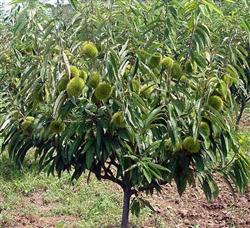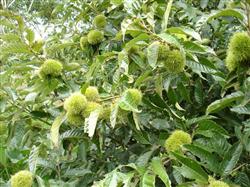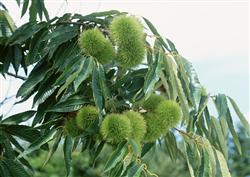How to plant and trim Chinese chestnut?

How do you plant and prune chestnuts? Please introduce chestnut planting and pruning can refer to the following methods: chestnut cultivation techniques 1. Select suitable plots: According to the characteristics of chestnut, the soil pH of the plot must be about 4~7, the plot should be in the middle and lower part of the mountain, the light is better, and the soil is best with light sandy loam. 2. Planting density: gentle slope land with 3 meters ×4 meters is appropriate; slope can be appropriately sparse, can be planted into 4 meters ×8 meters, so that forest and crop intercropping. 3. Soil preparation: flat land, according to the design of plant spacing, can dig into 80 cm ×80 cm × 80 cm big hole, dig more than 40 cm of mature mound on one side, less than 40 cm of raw mound on the other side, backfill topsoil and organic fertilizer, phosphorus fertilizer mixed under the pit, and then fill raw soil above. It is best to prepare the soil in summer and plant it in late autumn or early winter or spring of the following year. 4. Planting: According to the practice of chestnut planting for many years, the seedlings are planted first, and then grafted one year after survival. The growth is fast and the fruit is early. Grafted seedlings after planting slow seedling weight, generally grafted seedlings and seedlings planted at the same time, seedlings grafted than grafted seedlings planted in the same year growth potential stronger, higher yield. Planting depth is slightly deeper than the nursery depth of 2~3 cm, not too shallow nor too deep. After planting, it is necessary to step on it, irrigate it once, and after the water permeates, cover it with a layer of dry soil to keep moisture. 5. Fertilization: Fertilizer and water management is the basis of high quality and high yield of chestnut. Every year at the end of autumn and early winter to apply a base fertilizer, base fertilizer to farm manures mainly, add some phosphorus and potassium fertilizer, if necessary, to add some manganese fertilizer. N fertilizer is the main fertilizer for topdressing and germination, P and K fertilizer are the main fertilizer in June and July. 6. Intertill weeding: Intertill weeding continuously throughout the growing season to keep the soil loose and free of weeds, reduce water evaporation and nutrient consumption, and promote vigorous growth of plants. 7. Intercropping: Young orchards and sparsely planted orchards can be intercropped with green manure or crops to improve soil structure, improve soil fertility, and increase income. Grass can be planted with hairy vetch, white clover, small crown flower, etc., crops can be planted with soybean, black bean, peanut, sweet potato and other short stem plants. Shaping and pruning (1) Shaping: At present, chestnut tree shape, Hebei Province multi-use scattered layered shape; Shandong, Shaanxi multi-use open heart shape, practice has proved: open heart shape good shape, early fruit, high yield. Average height? 50~? 60 cm, three main branches or four main branches, the main branch attachment belt should be 20~40 cm, do not grow together. The specific method is: when the seedlings grow to about 1 meter high in June, 80 cm can be left to cut a little, about a week after cutting, the buds under the mouth can germinate, grow about 30~50 cm branches, and form a small crown in that year. If there is no urgent pruning, it can be cut from 80 cm in winter pruning (fixed stem), and the next year, three branches with suitable orientation are selected as main branches, and the height of main branches is 50~60 cm. When pruning in winter of the third year, it can be cut or picked from 40~50 cm, and the first lateral branch is selected from the branches sent out from the cut, the first lateral branch is about 45 cm away from the base of the main branch, and the second lateral branch is in the opposite direction of the first lateral branch, about 30 cm away from the first lateral branch, so that the shaping task can be completed in 3~4 years. (2) Trimming: young tree pruning is mainly to enlarge the crown and accelerate the crown formation, cultivate the fruiting mother branch, achieve the goal of early fruiting and early high yield, young trees have the habit of sending out 3~4 parallel strong branches, that is, three branches or four branches, can be sparse one slow two or sparse one or cut one slow two proportion sparse, in order to control polarity, maintain the balance of growth potential and opening angle among branches, can adopt the method of thinning straight and leaving oblique, thinning upper and leaving strong middle, for the thin weak branches below the extended branch, Except for the part reserved as auxiliary branches, all of them shall be thinned out. Perennial branch pruning: according to the requirements of different tree structures, dense branches and excessive branches other than the selected main lateral trunk branches, such as overlapping with the main lateral branches, opposite and competition for lower germination, should be thinned or controlled from the base to ensure the normal growth of the main and lateral branches, and pay attention to the angle of opening the main lateral branches. In order to achieve early high yield, the young tree branches can be removed, and when the branches grow to 30 cm, they can be removed to promote branching, and it is conducive to flower bud formation. Pruning mature trees, focusing on adjusting tree structure and balancing tree vigor, promoting strong fruiting mother branches, and solving the problem of poor light in the inner bore. To thin out pest branches, weak old branches, overlapping branches, cross branches and affect the tree shape of large branches. Click for more chestnut tree planting techniques Click for more fruit planting techniques
- Prev

How can chestnut trees be managed to produce a high yield?
How can chestnut trees be managed to produce a high yield? Please give guidance to chestnut trees can refer to the following methods for management: first, fertilizing spring pre-anthesis fertilizer can be applied 300 grams of urea and 200 grams of calcium 300 grams, and per square meter of borax 6 grams 7 grams. During the fruit bud expansion period in July, the plant applied strong fruit fertilizer and three-element compound fertilizer 0.7.
- Next

What are the varieties of Chinese chestnut?
What are the varieties of Chinese chestnut? Please introduce that the traditional chestnut production is real breeding, and the so-called varieties are some primitive groups, such as Zhenan chestnut, Changan Mingdong chestnut, Hanzhong gray chestnut, Xunyang chestnut, Baoji chestnut, Weinan chestnut, Huanglong chestnut and so on. After the 60 s of last century, we began to choose the best.
Related
- Moge, come on! The staff of the peasant association in the producing area of cantaloupe were frightened when the crowd gathered.
- Causes and Solutions of low Fruit setting rate of Apple
- Symptoms and control measures of passion fruit virus disease
- Fruit growing lesson: how do apple orchards keep high yields?
- Can you build orchards in the mountains? What are the pros and cons?
- How to manage the coloring period of Crisson grape?
- This paper introduces the processing technology of two kinds of fig products.
- How much is a month for retired teachers in rural areas by 2020?
- How can strawberry planting increase sugar content? We should pay attention to management in many aspects.
- What are the cultivation techniques on how to improve the yield of golden fruit?

